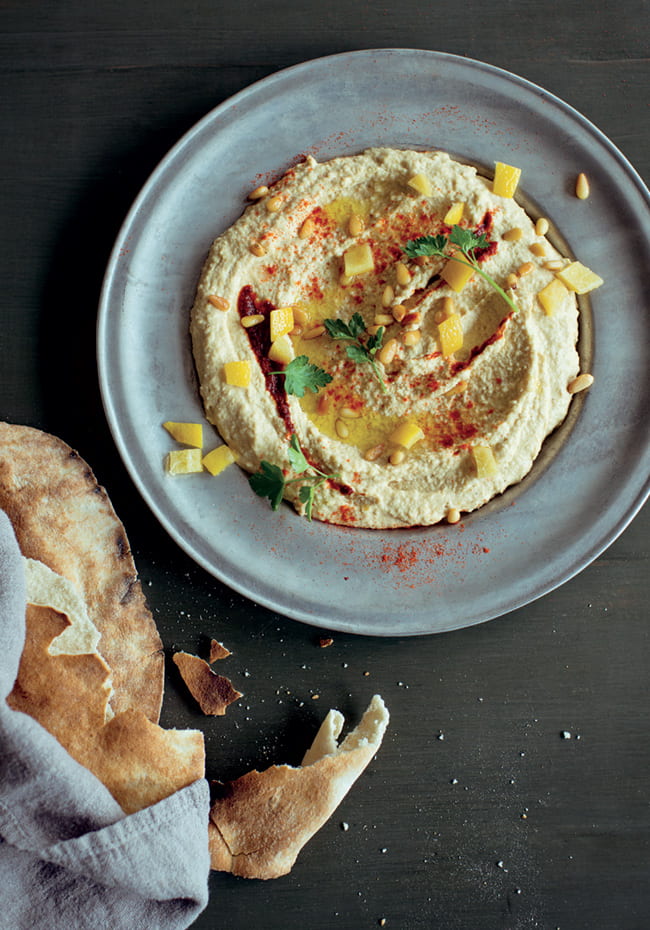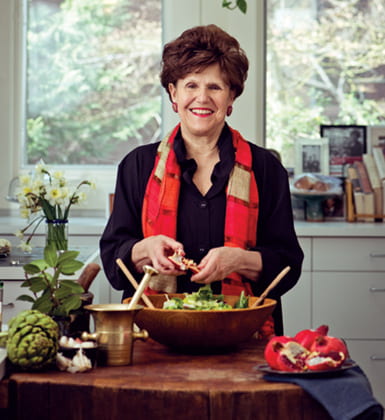
In Review
Savoring the Biblical Origins of Jewish Food
An interview with Joan Nathan
Hummus with preserved lemon. Courtesy Penguin Random House
Joan Nathan discovered her métier writing about Jewish food four decades ago. While working as a press secretary in Jerusalem for then mayor Teddy Kollek, she wrote her first book, The Flavor of Jerusalem (Little Brown and Co., 1975, 242 pages). (Kollek contributed the foreword.) Since then, she has published 11 books about Jewish food throughout the diaspora and has penned numerous columns—for The New York Times, The Washington Post, and other publications—on what she calls “the Jewish obsession with food.”
For her most recent book, King Solomon’s Table, she traveled the globe in search of the biblical origins of Jewish foods. Using a warm and engaging narrative style, combined with an impressive amount of research, Nathan connects the dots between these biblical roots and explains how Jewish food—which she says is thriving across the globe—has morphed over time.
Born and raised in Providence, Rhode Island, Nathan graduated from the University of Michigan, where she earned a bachelor’s degree in French literature. She later earned a master’s degree in public administration from Harvard’s Kennedy School. Nathan spoke to Harvard Divinity Bulletin contributor Robert Israel from her home in Washington, DC.

Joan Nathan. Photo by Gabriela Herman
Bulletin: King Solomon’s Table took you 6 years to write. During that time you visited 15 countries and 5 continents, researching the biblical origins of Jewish foods and how we prepare and eat them today. What was the inspiration to embark on this kind of journey?
Joan Nathan: During a family trip to India, I visited the Paradesi Synagogue in Kochi, Kerala. The walls of the synagogue are adorned with the history of the Jews in India. I found a reference there to King Solomon, suggesting that Jewish traders had crossed the Indian Ocean during Solomon’s reign.
That discovery set me off on my journey. I researched the Babylonian period, a time when most people worshipped many gods, tracing the early roots of Judaism. Since little is known about King Solomon, I began talking to archaeologists. I came to discover that Solomon was really what I call the first “foodie.” He commanded his representatives from the 12 tribes of Israel, after they completed their travels in the then-known world, to bring him food, spices, and precious stones to the temple in Jerusalem, which was also the site of his palace.
There is much debate among archaeologists regarding the authenticity of King Solomon. Some claim he was a mythic creation, the stuff of fiction. They point to the stories about him that describe his enormous appetite for life—he was rumored to have 700 wives and a multitude of concubines from many lands. While this sounds far-fetched, it’s not impossible to picture that these women brought to his palace a variety of foods from their native lands, as well as methods for preparing these foods, such as salting, drying, pickling. Other archaeologists claim Solomon really did exist. These archaeologists point to evidence that has been unearthed about King David, who was a warrior, and they believe that it will be only a matter of time before they discover ample evidence that King Solomon was real, too. With this in mind, I set forth in search of the biblical roots and evolution of Jewish cooking.

Syrian meatballs. Courtesy Penguin Random House
Bulletin: What did you discover along the way?
Nathan: As I traveled throughout the Jewish diaspora learning where Jewish foods come from, I noted three aspects that make Jewish food unique. First, there are the dietary laws—the laws of kashrut—that become part of your life as a Jew. The laws of keeping kosher are as intrinsic to one’s Jewish identity as hymns and daily prayers. Second, throughout their history, Jews have gone out in search of food that is in touch with their dietary laws. Third, because Jews were kicked out of so many countries throughout history, they adapted to other cultures in their adopted lands, and their recipes reflect this cultural adaptation.
Take, for example, the tiny country of El Salvador. There are around 100 Jews living there today. Their ancestors migrated there from Alsace-Lorraine in France and from Germany after the First World War. When I visited them, they served me latkes—traditional pancakes fried in oil. But they made their latkes with yuca, also known as the cassava root. They refer to yuca as a potato. But since potatoes are costly and therefore hard to get in El Salvador, they use instead an ingredient they’ve found in abundance where they live, and they have learned to adapt it for making latkes and other dishes.
Bulletin: You describe your research at the Sterling Memorial Library at Yale University, where you examined clay cuneiform tablets dating from 1700 BCE. What did you learn about the origins of Jewish food from this?
Nathan: As I started tracing the origins of Jewish food, I realized that many foods came from Babylonia, where Abraham came from before he moved to the land of Canaan.
I learned a lot about what the earliest food looked like. Sesame, for example, was recorded to be in use as far back as 2500 BCE, and it probably came from China. The use of chickpeas was first recorded in Jordan, around 8,500 years ago, and this is among the earliest examples of protein we have. There is reason to believe that hummus existed back then, too, but it was made without using lemons, since lemons arrived in the Middle East from China at a later date. People made pancakes out of chickpea flour back then, too. Chickpeas are not only a food of the past, they are a food of the present and future.
This statement has been attributed to King Solomon: “There is nothing new under the sun” (Ecclesiastes 1:9). There is truth to that statement. Pomegranate paste and date jam existed in biblical times—there are references to them in the Bible—and these are foods that are enjoyed today. In many ways, these foods have come full circle because now they are quite popular. According to the Bible, followers of God were all vegans until after the Flood. Today, we hear a lot about “vegan” and “gluten-free” foods. But these special diets have existed in Jewish food and culture for centuries. They are easily incorporated into Jewish dietary laws.

Hungarian golden pull-apart cake. Courtesy Penguin Random House
Bulletin: Do you rely on a network of contacts, friends, and chefs accumulated from your long career?
Nathan: Yes, very much so. I traveled to Cuba—about 1,000 Jews live there today—after I heard about a trip that was leaving in a week’s time from Washington, DC, from some people I know, as it happened, so I decided to travel with them. One of my neighbors is the ambassador to El Salvador, so I traveled there with her. I enjoy tracing Jewish migrations, and I find it fascinating to meet Jews in communities everywhere. I’m especially interested in writing about Jews in tightly knit, confined communities. Canada, for example, is an example of a confined Jewish community. Along the way, while researching and writing the book, I met a lot of people—cinnamon growers, chicken farmers, diplomats, rickshaw drivers, Talmudic scholars, and many others—and their stories and recipes are in the book.
Bulletin: There are over 170 recipes included in your book. What other examples can you give to illustrate foods we eat today that have biblical origins?
Nathan: In Deuteronomy (8:7–10), we learn that “God is bringing you into a good land, a land with streams and springs . . . a land of wheat and barley, of vines, figs, and pomegranates, a land of olive trees and honey; a land where you may eat food without stint, where you will lack nothing.” Therefore, I include a recipe from Julia Braun, from Bandon, Oregon, which incorporates the foods mentioned in that Bible passage—wheat berries, barley, olives, figs, dates, grapes, and pomegranate—into a salad that can be served year-round.
Beets have also been popular since earliest times. In my book I include a recipe for Moroccan beet and orange salad, a very colorful and flavorful dish. I write that in many Jewish communities there are multiple recipes for preparing beets, as beets have been thought to have curative powers throughout time. They have been used as a way to ward off diseases such as leprosy and ra’anan, a skin disease causing extreme disability and nervous trembling. Beet juice has been used as a dye. According to the Mishnah, written in 200 CE, during Rosh Hashanah one is required to serve at least seven vegetables for the New Year, and when the High Holy Days arrive, I include beets during my meals.
Bulletin: Where is Jewish cooking heading in the twenty-first century? Are Jews exploring new cuisines? Are they drawing from the past or are they charting new territories?
Nathan: During my travels to Jewish communities around the world, I continually meet Jews who are looking for new ways to prepare food that comply with the religion’s dietary laws. Those dietary laws are what hold communities together. Finding different ways to make Jewish food is what makes Jews true innovators in the food industry. I call this global explosion of interest in Jewish food “Newish Jewish.” It is taking place everywhere. All of a sudden, Jewish food is becoming more and more popular, and I don’t mean deli food, which everyone associates with being Jewish food. Take, for example, a Newish Jewish restaurant named Meshugganah (Yiddish slang meaning “crazy”) that opened recently in Buenos Aires, Argentina. At this restaurant, chefs are taking recipes from their Eastern European grandparents, serving them in smaller plate portions (tapas), and blending their dishes—tabouleh, baba ghanoush, roasted cauliflower—with spices and other ingredients that are found in South American and Israeli food. They are putting new spins on Jewish cuisine. There are Jewish or Israeli-themed restaurants in Japan, in Spain, and in England. A Jewish restaurant opened recently in Portland, Oregon. There are new Jewish restaurants in Washington, DC, and one I just learned about—it serves Middle Eastern/Israeli food—is located in West Hartford, Connecticut. There’s a Jewish restaurant in New Orleans, too, and when I was there not long ago, I saw the Zulu King of New Orleans at a table seated beside two African American gentlemen and they were eating hearty portions of Jewish food.
People today are not eating as much meat as they used to, so this current craze, this food trend, is one where people are eating more vegetarian food. What is attractive to them is how Jews prepare these foods, particularly in the Middle East. I recently was interviewed for a documentary, In Search of Israeli Cuisine, hosted by Israeli chef Michael Solomonov. In that program, Solomonov introduces us to pioneering chefs from throughout Israel who are doing wonderful new things with Jewish/Israeli food. While people may not like Israeli politics, they seem to love Israeli food. Israeli food is triumphing around the world.
Bulletin: What current writing projects are you pursuing?
Nathan: My publisher wants me to write “The Essential Joan Nathan,” which will be composed of recipes from my other books and new ones, too. I’m still writing food columns for The New York Times. I have an interest in doing some more writing on Ethiopian kosher food and also on kosher food in Vietnam. I’m a grandmother to two grandchildren, and I want to spend more time with them. I’ve been writing about Jewish food my entire life. It’s never boring. For me, it is an endlessly fascinating subject.
Please follow our Commentary Guidelines when engaging in discussion on this site.


hai im jasa buzzer from Indonesia. thanks for the information.